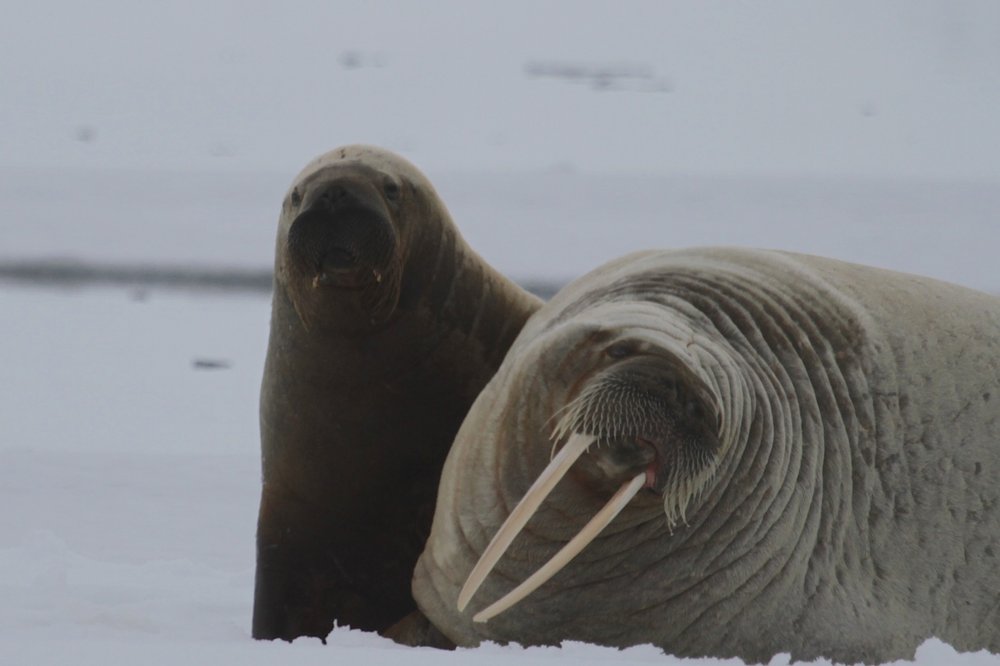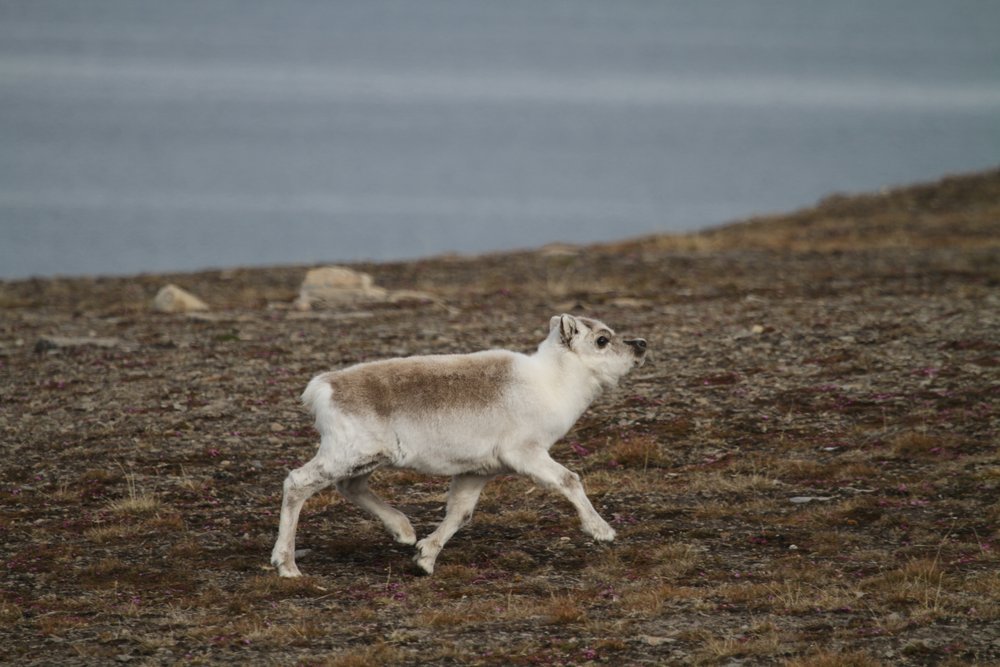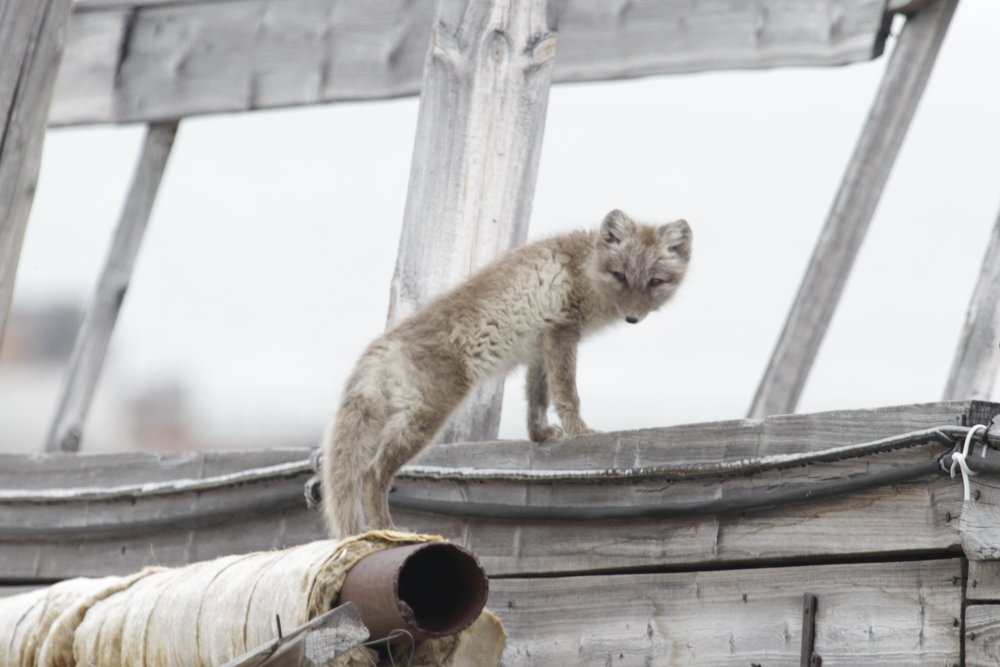 Walrus, protected since 1952Reading polar literature for someone who loves the natural world is a challenge. Every journey involves a fair amount of brutality, of killing. On most expeditions the dogs are at once loved and needed but also overworked, often killed, sometimes eaten. That was the case with Amundsen heading to the South Pole. He feeds the dogs to the remaining dogs, but he also eats them: “we have now had three splendid dinners out of our good Greenland dogs,” writes one of his shipmates. Yet Amundsen loved his dogs (at times it seems more than the men) and in writing about them is at his most philosophical. Killing the dogs is a horror: “It is my only dark memory from down there, that my lovely animals were destroyed.” The treatment of the dogs is also something that Nansen feels keenly “It was undeniable cruelty to the poor animals from first to last, and one must often look back on it with horror. It is the sad part of expeditions of this kind that one systematically kills all better feelings, until only hard-hearted egoism remains.”
Walrus, protected since 1952Reading polar literature for someone who loves the natural world is a challenge. Every journey involves a fair amount of brutality, of killing. On most expeditions the dogs are at once loved and needed but also overworked, often killed, sometimes eaten. That was the case with Amundsen heading to the South Pole. He feeds the dogs to the remaining dogs, but he also eats them: “we have now had three splendid dinners out of our good Greenland dogs,” writes one of his shipmates. Yet Amundsen loved his dogs (at times it seems more than the men) and in writing about them is at his most philosophical. Killing the dogs is a horror: “It is my only dark memory from down there, that my lovely animals were destroyed.” The treatment of the dogs is also something that Nansen feels keenly “It was undeniable cruelty to the poor animals from first to last, and one must often look back on it with horror. It is the sad part of expeditions of this kind that one systematically kills all better feelings, until only hard-hearted egoism remains.”
 Young reindeer, protected since 1925The dogs are one story; the killing of wildlife another. South polar literature has less bloodshed, mostly because once the explorers are moving across the continent there’s nothing to kill (near the coast there are, of course, penguins and seals to be killed). In the north, living by ones rifle is part of the game and the fresh meat helped to keep away scurvy. And though Nansen does kill a lot, and describes it in agonizing detail at times, he takes no pleasure in this. Neither did Amundsen who was never a sport hunter. Nansen’s thoughtfulness comes through even as the trigger is pulled on a walrus: “It was a touching sight to see her bend over her dead young one [which he had shot] before she was shot, and even in death she lay holding it with one fore-leg.” And then he soon turns to what matters to him: “the side of young walrus tastes like loin of mutton.”
Young reindeer, protected since 1925The dogs are one story; the killing of wildlife another. South polar literature has less bloodshed, mostly because once the explorers are moving across the continent there’s nothing to kill (near the coast there are, of course, penguins and seals to be killed). In the north, living by ones rifle is part of the game and the fresh meat helped to keep away scurvy. And though Nansen does kill a lot, and describes it in agonizing detail at times, he takes no pleasure in this. Neither did Amundsen who was never a sport hunter. Nansen’s thoughtfulness comes through even as the trigger is pulled on a walrus: “It was a touching sight to see her bend over her dead young one [which he had shot] before she was shot, and even in death she lay holding it with one fore-leg.” And then he soon turns to what matters to him: “the side of young walrus tastes like loin of mutton.”
It is looking into the eyes of a dying animal that is the test of the hunter. Nansen again, writing about a walrus: “There was something so gently supplicating and helpless in its round eyes as it lay there that its goblin exterior and one’s own need were forgotten in pity for it. It almost seemed like murder. I put an end to its sufferings by a bullet behind the ear, but those eyes haunt me yet; it seemed as if in them lay the prayer for existence of the whole helpless walrus race.”
 Arctic Fox, with limited protectionNow, of course, all of these walrus on Spitsbergen are protected and have been since 1952. The Svalbard reindeer was protected as early as 1925, and the polar bear in 1972. The Arctic Fox has limited protection (that is, it can be trapped during certain periods), and populations are stable in Svalbard. But what isn’t protected are the oceans around this archipelago. The US proposed at a meeting in February of 2014 to put a moratorium on fishing in the central Arctic ocean, the region of the Arctic that has until now been covered in ice. Melting polar ice is opening up new territory, and that region needs to be studied before commercial fishing moves in. But the Arctic waters we floated off Spitsbergen are open to commercial fishing.
Arctic Fox, with limited protectionNow, of course, all of these walrus on Spitsbergen are protected and have been since 1952. The Svalbard reindeer was protected as early as 1925, and the polar bear in 1972. The Arctic Fox has limited protection (that is, it can be trapped during certain periods), and populations are stable in Svalbard. But what isn’t protected are the oceans around this archipelago. The US proposed at a meeting in February of 2014 to put a moratorium on fishing in the central Arctic ocean, the region of the Arctic that has until now been covered in ice. Melting polar ice is opening up new territory, and that region needs to be studied before commercial fishing moves in. But the Arctic waters we floated off Spitsbergen are open to commercial fishing.
One morning we woke in front of the Recherche glacier in the Belsund Fjord. The Antigua had traveled all night, south from our highest point. What we had left behind was ice, a snow-covered landscape. It felt like we had awakened in a new world. Not only was there less snow and ice, but near us two ships rafted up. Other humans felt odd when we had been so isolated in the ice. Now here we were, rubbing elbows with Russian fishing ships.
 Russian fishing shipThe captain stood near me on deck and explained in his impeccable German accent how they fish. “Imagine the ship is an airplane. When they throw their net into the water, it is as if they tossed down a net from the sky. The net hauls up everything the plane flies over: trees, houses, cars, people. The only thing it wants are the horses, but it gets everything else, all piled together. Most of it is killed by the time the net comes up so even if it is protected that doesn’t matter.” He shrugged and walked away, disgusted.
Russian fishing shipThe captain stood near me on deck and explained in his impeccable German accent how they fish. “Imagine the ship is an airplane. When they throw their net into the water, it is as if they tossed down a net from the sky. The net hauls up everything the plane flies over: trees, houses, cars, people. The only thing it wants are the horses, but it gets everything else, all piled together. Most of it is killed by the time the net comes up so even if it is protected that doesn’t matter.” He shrugged and walked away, disgusted.
All of this unwanted fish are referred to in the fishing industry as “bycatch” or “trash fish.” A net holds mostly trash fish. For instance, a shrimp trawler on the Gulf Coast pulls in 16 percent shrimp. The rest is a range of fish, all of which is dumped back into the ocean, alive or dead. Some chefs, I learn, are trying to take advantage of that bycatch by using these fish that would otherwise die. A small step. But a bigger step is needed.
I am not opposed to hunting or fishing, but throwing a net is not fishing. Hunting and fishing involve an exchange: every fisherman and every hunter should, like Nansen, look into the eye of what they kill.



 Russian fishing shipThe captain stood near me on deck and explained in his impeccable German accent how they fish. “Imagine the ship is an airplane. When they throw their net into the water, it is as if they tossed down a net from the sky. The net hauls up everything the plane flies over: trees, houses, cars, people. The only thing it wants are the horses, but it gets everything else, all piled together. Most of it is killed by the time the net comes up so even if it is protected that doesn’t matter.” He shrugged and walked away, disgusted.
Russian fishing shipThe captain stood near me on deck and explained in his impeccable German accent how they fish. “Imagine the ship is an airplane. When they throw their net into the water, it is as if they tossed down a net from the sky. The net hauls up everything the plane flies over: trees, houses, cars, people. The only thing it wants are the horses, but it gets everything else, all piled together. Most of it is killed by the time the net comes up so even if it is protected that doesn’t matter.” He shrugged and walked away, disgusted.